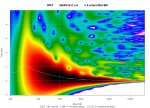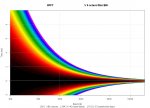With both the scrutiny and encouragement of Mark, Michael, and others here I revisited the TFE program, which I now refer to as a "short frequency Fourier transform" or "SFFT", in analogy to the short time Fourier transform.
First, I spiffed up the color palette of the contour plot to make it look more like Raimonds's. Looks are important. I ditched the superfluous input window. And, most importantly, I figured out where the high frequency artifacts are coming from. Although the input spectrum is band-limited for most purposes, it is still numerically non-zero at N/2 where it is truncated in order to generate the analytic signal on return to the time domain. When the abrupt drop to zero is multiplied with the filter windows it's still an abrupt drop to zero and causes Gibbs-like ringing in the time domain. Now I apply a half raised cosine window to the spectrum starting at the highest frequency of interest and extending up to fs/2. This pretty well fixes it, even for a non-band limited test signal, and, I believe, nails it for any actual measured impulse responses.
Example pictures below. The first is of a measured impulse response, the second of an ideal impulse with the same settings.
--Frank


First, I spiffed up the color palette of the contour plot to make it look more like Raimonds's. Looks are important. I ditched the superfluous input window. And, most importantly, I figured out where the high frequency artifacts are coming from. Although the input spectrum is band-limited for most purposes, it is still numerically non-zero at N/2 where it is truncated in order to generate the analytic signal on return to the time domain. When the abrupt drop to zero is multiplied with the filter windows it's still an abrupt drop to zero and causes Gibbs-like ringing in the time domain. Now I apply a half raised cosine window to the spectrum starting at the highest frequency of interest and extending up to fs/2. This pretty well fixes it, even for a non-band limited test signal, and, I believe, nails it for any actual measured impulse responses.
Example pictures below. The first is of a measured impulse response, the second of an ideal impulse with the same settings.
--Frank


